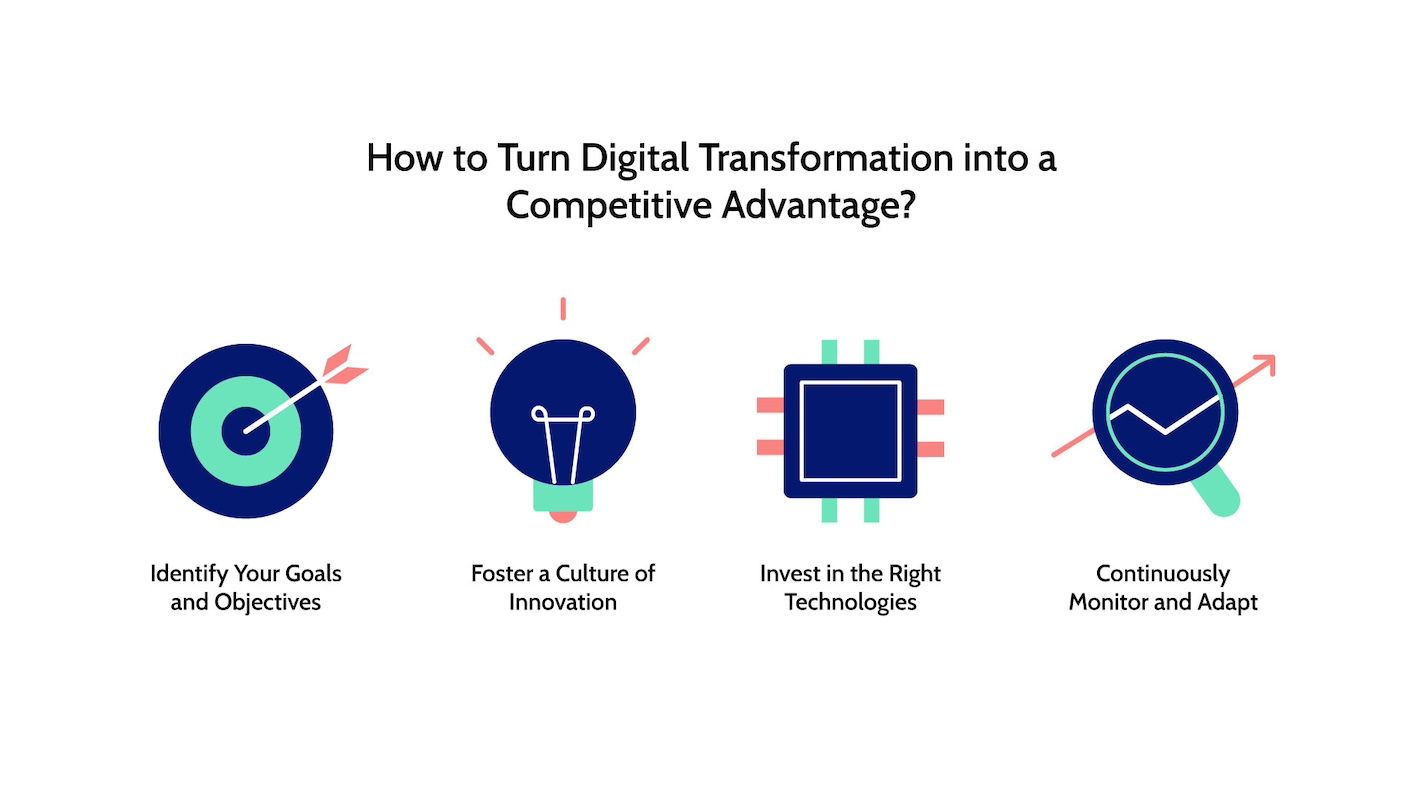In today’s fast-paced business landscape, digital transformation has become a buzzword. Companies across industries are investing in digital technologies to stay ahead of the curve and remain competitive. But what exactly is digital transformation, and how can it give your business a competitive edge? In this article, we’ll explore the concept of digital transformation and how it can be leveraged to turn your business into a market leader. You can listen to a deep dive
(Generated in Google Notebook LM) into the key points from this article here:
What is Digital Transformation?
Digital transformation is the integration of digital technologies into all areas of a business, fundamentally changing how it operates and delivers value to customers. It involves the use of technology to streamline processes, improve efficiency, and enhance the customer experience. Ultimately, Digital Transformation marks a rethinking of how companies use technology, people and processes in pursuit of new business models and new revenue streams, driven by customer expectations around products and services.
The Importance of Digital Transformation
In today’s digital age, businesses that fail to embrace digital transformation risk falling behind their competitors. Customers now expect seamless digital experiences, and companies that can’t keep up will lose market share. Digital transformation also allows businesses to stay ahead of industry trends and adapt to changing customer needs. By leveraging technology, companies can improve their agility and respond quickly to market changes, giving them a competitive edge. 
How Can Digital Transformation Give Your Business a Competitive Advantage?
Digital transformation can provide your business with a competitive advantage in several ways.
Improved Efficiency and Cost Savings
One of the main benefits of digital transformation is improved efficiency. By automating manual processes and streamlining workflows, businesses can save time and reduce costs. This allows them to reallocate resources to other areas of the business, such as innovation and customer experience. For example, a retail company that implements a digital inventory management system can reduce the time and resources spent on manual inventory tracking. This not only saves money but also frees up employees to focus on other tasks, such as improving the customer experience.
Enhanced Customer Experience
In today’s digital world, customers expect a seamless and personalised experience from businesses. Digital transformation allows companies to collect and analyse customer data to gain insights into their preferences and behaviours. This data can then be used to create personalised experiences for customers, improving their overall satisfaction and loyalty. For instance, a retail company that operates both online and physical stores can enhance the customer experience by aligning its channels to offer a unified shopping journey. This can be done by implementing a CRM to unify the customer profiles, cleaning up legacy data and ensuring optimised data capture, implementing AI powered recommendations, providing a seamless integrations of channels and introducing an enhanced loyalty program.
Increased Innovation and Agility
Digital transformation enables businesses to innovate and adapt to changing market conditions quickly by modernising processes, enhancing decision-making, and fostering a culture of continuous improvement. Leveraging new technology, companies can develop new products and services, enter new markets, and respond to customer needs faster than their competitors. For example, a manufacturing firm incorporates AI, machine learning and 3D printing into its R&D department to simulate product prototypes and test them virtually, 3D printing designs that pass initial virtual testing. AI allows for multiple design iterations and testing within a fraction of the time needed for traditional physical prototypes, leading to more creative and effective product designs. Faster prototyping means the company can iterate based on feedback and adjust product features promptly before full-scale production.
How to Turn Digital Transformation into a Competitive Advantage?
To turn digital transformation into a competitive advantage, businesses need to have a clear strategy in place. Here are some steps you can take to ensure your digital transformation efforts give you a competitive edge.
Identify Your Goals and Objectives
Before embarking on a digital transformation journey, it’s essential to identify your goals and objectives. What do you want to achieve through digital transformation? Is it to improve efficiency, enhance the customer experience, or increase innovation? Having a clear understanding of your goals will help you determine which digital technologies to invest in and how to measure the success of your transformation efforts.
Invest in the Right Technologies
Investing in the right technologies is crucial for a successful digital transformation. It’s essential to choose technologies that align with your business goals and objectives. Use technology as an ENABLER. For instance, if your goal is to improve efficiency, investing in automation and workflow management tools would be beneficial, however, bringing in a new shiny tool without clearly defining the new processes and associated workflows of the impacted business units as well as involving the team and bringing them on the journey of this change will lead to ultimate project failure. It’s also important to consider the scalability and compatibility of the technologies you choose. Will they be able to support your business as it grows and evolves? Can they integrate with your existing systems? Do you have the right data strategy in place for the new systems?
Foster a Culture of Innovation
Digital transformation is not just about implementing new technologies; it also requires a cultural shift within the organisation. To truly leverage digital transformation for a competitive advantage, businesses need to foster a culture of innovation. This involves encouraging employees to think outside the box, experiment with new ideas, and embrace change. It also means providing employees with the necessary training and resources to adapt to new technologies and processes.
Continuously Monitor and Adapt
Digital transformation is an ongoing process, and businesses need to continuously monitor and adapt their strategies to stay ahead of the curve. This involves regularly reviewing and updating your digital transformation plan to ensure it aligns with your business goals and objectives. It’s also essential to keep an eye on industry trends and emerging technologies that could give your business a competitive edge. By staying informed and adaptable, businesses can ensure their digital transformation efforts continue to provide a competitive advantage. 
Real-World Examples of Digital Transformation as a Competitive Advantage
Domino’s Pizza
With the recent exit of Domino’s Pizza Australian CEO, Don Meij following a hugely successful career, its only fair to shine the light on this pizza chain which has has been a leader in using digital transformation to stay ahead in the highly competitive food delivery industry. The company embraced technology very early on to enhance customer experience and streamline its operations.
Digital Transformation Strategies:
- Online Ordering and Mobile App: Domino’s was one of the first major pizza chains to launch an online ordering platform and a user-friendly mobile app. This app allowed customers to order quickly and track their delivery in real-time.
- Domino’s AnyWare: The company introduced this platform to let customers order pizza using various digital interfaces such as smart TVs, smartwatches, voice assistants (e.g., Amazon Alexa), and even through social media channels like X.
- AI and Machine Learning: Domino’s integrated AI to enhance its supply chain management and improve inventory forecasting, reducing waste and ensuring product availability.
- Autonomous Delivery Vehicles: The company has tested self-driving vehicles and drones for pizza delivery, showcasing a commitment to staying ahead in last-mile delivery innovation.
Competitive Advantage:
- Customer Experience: The seamless ordering process and innovative delivery options have attracted tech-savvy customers, improving customer retention and satisfaction.
- Operational Efficiency: Streamlined operations through technology have reduced costs and improved order accuracy and speed, setting Domino’s apart from competitors who rely on traditional methods.
Chemist Warehouse
Chemist Warehouse is one of Australia’s largest pharmacy chains, operating over 400 stores nationwide. Known for its competitive pricing and extensive product range, the company has embraced digital transformation to enhance customer experience, streamline operations, and strengthen its position in the retail pharmacy sector.
Digital Transformation Strategies:
- E-Commerce and Mobile Platforms:
- Online Shopping Experience: Chemist Warehouse developed a robust e-commerce platform, allowing customers to browse and purchase products online with options for home delivery or click-and-collect from their nearest store.
- Mobile App: The company launched a user-friendly mobile app that provides convenient access to product catalogs, prescription services, and personalised offers.
- Digital Prescription Services:
- E-Prescriptions: By adopting electronic prescription services, customers can send prescriptions directly to the pharmacy via the app or website. This reduces wait times and enhances convenience, especially important during times when in-person visits may be challenging.
- Medication Management Tools: The app includes features that help customers manage their medications, such as refill reminders and dosage instructions.
- Omnichannel Integration:
- Click-and-Collect and Drive-Thru: Integrating online and offline channels, customers can order products online and pick them up in-store or via drive-thru services, catering to various customer preferences.
- Real-Time Inventory Management: Implementing systems that provide real-time updates on product availability across all platforms ensures accurate information and improves customer satisfaction.
- Personalisation :
- Data Analytics: Utilising customer data to analyse buying patterns helps tailor marketing strategies and improve product offerings.
Competitive Advantage:
- Enhanced Customer Convenience: Offering multiple channels for shopping and prescription services meets diverse customer needs, increasing satisfaction and loyalty.
- Operational Efficiency: Digital integration reduces manual processes, improves supply chain management, and streamlines inventory control.
- Expanded Market Reach: The e-commerce platform allows Chemist Warehouse to serve customers beyond their physical store locations, including those in remote or underserved areas.
- Data-Driven Decision Making: Insights from data analytics enable more effective marketing strategies and product development, staying ahead of consumer trends.
Who is Responsible for Digital Transformation?
Digital transformation is a team effort, and it’s essential to have buy-in from all levels of the organisation. However, the responsibility for driving digital transformation often falls on the shoulders of the C-suite, starting with the CEO. The CEO in partnership with the rest of the C-suite are responsible for developing and implementing a digital transformation strategy that aligns with the company’s goals and objectives. They also oversee the adoption of new technologies and ensure that the organisation has the necessary resources and support to embrace digital transformation.
In A Nut Shell
Digital transformation is no longer a choice for businesses; it’s a necessity. By embracing digital technologies and leveraging them strategically, businesses can gain a competitive advantage and stay ahead of their competitors. By following the steps outlined in this article and learning from real-world examples, you can turn digital transformation into a competitive advantage for your business.
We are Digital Smoothie
Enjoy reading about AI, Digital Transformation and Technology?
Here are some articles from our Digital Transformation series that you might enjoy:
Six Questions To Assess Your Company’s Digital Transformation Readiness
Is Culture The Missing piece Of Your Digital Transformation Strategy?








Leave a Reply